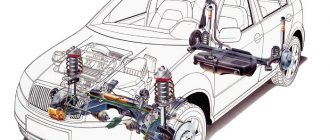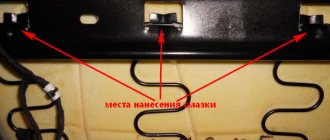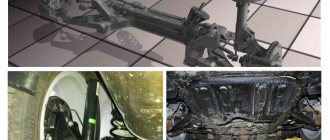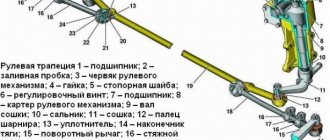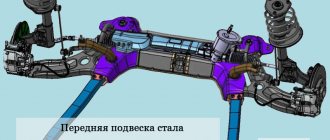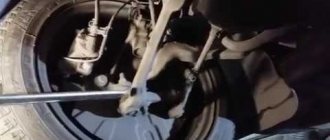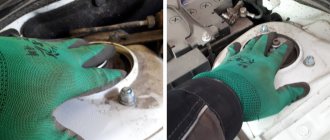see also
Comments 32
I put comfort on the front of the SS20, and after 300 km a dull knock appeared, although on the driver’s side I went through the entire suspension, it turned out that there was a small play in the strut, barely noticeable, but in the assembly there was a strong impact on the body. I changed the struts, everything was gone.
Thank you! But judging by the backlash of the prop, it’s because of it
it was the same. I changed absolutely everything (including the supports), but the sound remained. it turned out to be a rack
My support driver was hammering on the left on small bumps at low speed
What supports did you replace with?
Balakovsky staged (BRT). The previous ones were also from Balakovo, they cost 50 thousand of hard use, I didn’t see any point in installing something expensive
I don’t remember exactly, it’s like 700 rubles each (I have Priora support frames and struts). The old prop did not show himself at first, then he began to click when swinging his arms
What supports did you replace with?
Also, the hood hinges may rattle (the symptoms are the same, diagnostics do not detect the rattling noise from the hinges ). Another problem was that the spring on the front block had burst. There was a noise from outside, as if a tin can had been tied to a wheel.
). Another problem was that the spring on the front block had burst. There was a noise from outside, as if a tin can had been tied to a wheel.
No it's just a dull sound
The supporter was deaf ((
The same canoe on the 12th, and also on the right side. I climbed everything and went for diagnostics, they said if you find out, come and tell me. The entire chassis on the front end has been changed, and it also knocks on small bumps. If you find where it is knocking, please write back.
I found it! it's a support bearing
maybe a ball joint. and maybe also try tightening the caliper!
There’s definitely something in the running, but I’ve already found it
check the door hinges, I was wondering where the knock came from and it turned out to be a hinge))
I have a similar situation... First one side, then the other. In the summer, everything in the suspension was replaced except the supports. I changed the supports two years ago and installed SS20. The mileage on them is 50,000 km. With our roads, I think this is an excellent result. Ordinary supports are enough for a year, and then only with a stretch. I will take SS20 again. Maybe only Queen. Now I have standard
99% reference, I recently changed it myself. The diagnosis was exactly like yours, after the replacement there was silence.
And a couple of months ago I changed the suspension and support parts, well, recently I just noticed something, I saw something hitting the protection, but there is still some kind of dull metallic sound, maybe some kind of rack or rod thread? What could be rattling there?
ss20 simple or queen? In simple ones, there seems to be nothing structural to knock (unless the top nut has been unscrewed). I have had normal flight on a simple SS20 for about 7 years now (pah-pah-pah)... If there are cartridges in the suspension (if the boots were collapsible), the top nut in the boot could have come loose
Check the protection and exhaust - they can rattle so much that you can’t hear it from the outside, but inside the sound is just terrible. I came across this myself a couple of times on two different machines.
Everything has been upgraded to a new exhaust
Check the protection and exhaust - they can rattle so much that you can’t hear it from the outside, but inside the sound is just terrible. I came across this myself a couple of times on two different machines.
Something rattled at me too, the suspension is completely new, I blame the protection and the exhaust too
Place one hand on the support bearing, and with the other hand try to rock the car, not too much, so that the shock absorber does not begin to compress. In general, you pump slowly, if your hand feels small shocks, then the supporter is PPC... the person below already wrote about this... here is an example
Along the way they! there is a tapping! it’s a pity that it’s ss20
Look at the steering joint, you probably haven't tightened it yet
For example, I had supports. Diagnostics is simple: you hold your palm on the support, your partner rocks the car, if there is a knock or beating, then it is definitely there. try.
Checked there is tapping! It's a pity that it's ss20
I installed stock for now. and Asomi's plans. (finance finance...)
Before considering all possible malfunctions of the front suspension on the VAZ 2110, you should remember what the front suspension structure is. This is a telescopic independent suspension with cylinder-shaped coil springs, anti-roll bar, transverse lower arms with braces and shock-absorbing hydraulic struts. Of course, all car owners know that the main element of the suspension is the shock absorber. The term itself translated from French means to soften or weaken.
Automobile shock absorbers are designed, first of all, to ensure stability and controllability of the car, dampen the sprung and unsprung masses of the car, reduce body roll during braking, ensure a smooth ride and prevent the wheels from lifting off the road. Due to all the above functions, it is considered the most important suspension part in any vehicle. The safety of passengers, the driver, as well as the safety of the car depends on the serviceability of this element.
What indicates a malfunction?
This is the proverbial 20 miles of bad road. However, it's worth it for a wonderful weekend of deep woods and hiking. Getting back to civilization without the heavy load of refreshment and food seems easier on your car and your fresh, relaxed psyche. At least until you hit the pavement and start rumbling. Maybe you couldn't hear it on a dirt road, but every widening lane on the interstate makes your car sound like a tin bath full of bolts.
Other possible options
If there are any problems in the strut supports in the front of the car, then none other than a regular speed bump can identify them. In this case, the noise is heard just at the moment of its intersection. It is somewhat similar to the creaking of ball joints, but at the same time is less clearly audible.
In order to accurately understand that the problem is in the racks, you need to do the following. While standing still, turn the steering wheel first in one direction and then in the other several times. The problem may not be regarded as critical if the creaking is barely audible.
In addition, the presence of a knock on turns is not always associated with wear of the ball joints.
- In practice, it often turns out that the reason for this is the poor quality of the anthers, since the lubricant is washed out of them quite quickly.
- Therefore, most often in dry weather, dry creaking becomes the most noticeable.
- If you listen to the movement of the car during rainy weather, then this feature disappears, which once again proves the correctness of this assumption.
You can always inject brake fluid or WD-40 into the boot using a syringe without a needle to get rid of the unpleasant squeaking. However, correcting the situation for a certain time will not help completely solve the problem.
And it quickly leads to accelerated wear of the support liner, which has had time to run dry for some time. Not much time later, you will still have to replace the ball joint.
What should you do if you periodically hear noise and knocking in the front suspension of your VAZ 2110?
You shouldn’t immediately rush to a car dealership and pay for expensive, pointless services for something you can do yourself, for example, or in our case, repairing the front suspension. It should be mentioned that many motorists try to realistically assess the quality of shock absorber struts and, therefore, hold them responsible for any problem that is associated with noise and knocking from the front suspension. This opinion is not unfounded, however, there are other reasons for the phenomenon in question. Do not forget that noise occurs not only due to a malfunction of the struts, but also as a result of a malfunction of another suspension element. In this case, you should study the front suspension diagram in detail, and only then can you determine whether the front suspension arm needs to be replaced or a smaller repair can be done.
Communities › Lada 2110, 2111, 2112, 112, Bogdan › Forum › Knock from rear right 2110
Hi all! There was a knocking noise from the rear right, I went to the service station for diagnostics, they said everything was fine! There is also nothing to rattle in the trunk. The knock is clearly audible at 40-60 km/h (in the pits). Please tell me what could be the reason! Very annoying! When the car is loaded, the knocking is even louder, and in wet weather! Mystic)
The rack itself, the upper mount of the rack, the silent blocks of the beam, the muffler on the body
all options were checked!)) I looked on the forums, this problem was more common on Priors! Everything is fine, but something is knocking))
Is there dirt or water inside the glasses? In general, I have the same thing, only on both sides, yesterday I went to get the chassis checked, they said it was just the struts, everything else is fine
What indicates a malfunction?
Motorists notice a problem when they hear a knocking sound in the front suspension. It is not yet a signal that it is necessary to contact a car service, except in cases where parts have begun to break down, and even a beginner can determine this. The driver should learn to distinguish which sounds are completely natural and which indicate a breakdown.
It may be time to walk away from this car. Of course, some noises that come from under the car have nothing to do with the suspension or steering systems, but this can be difficult to determine. For example, take the exhaust system - muffler, pipe and tailpipe, and catalytic converter. If everything is not on the right side or the hangers are loose or broken, it is possible that there will be accidental contact between them and the body or drive belt, as well as the associated lever.
Try forcing the system from outside to see if you can duplicate the sound. A broken motor mount can cause severe shock. Soaking the oil could have caused it to delaminate, or perhaps a couple of bolts were loose. This condition will be sensitive to the throttle being turned on or off, but will not be detected by the bumps.
When you hear a knock in the front suspension, you should not immediately panic. This unit is quite reliable and strong. It will take a long time or strong mechanical impact before it completely fails.
Consequences of ignoring a knock
Any extraneous sounds that appear while driving must be identified without delay, as their presence may indicate a serious malfunction. In this case, let’s look at the consequences of knocking in the rear suspension:
In most cases, a knock in the rear suspension is detected almost immediately, as it occurs while overcoming a bump or pothole on the road. As a rule, suspension elements fail after their service life has expired. If you replace parts in a timely manner, you can avoid road accidents and serious material costs.
Problems you can fix yourself
It is worth noting that the reasons for knocking in the front suspension can be different, and there are quite a lot of them. The most harmless of them is that the motor protection has lost some of its fasteners. Therefore, on an uneven surface it makes sounds that are similar to the knocking of worn parts. However, motorists should be aware that a foreign object could also get into the suspension connections. The listed faults are easy to identify during the diagnostic process and then eliminated.
Even though we have seen people try to remove the gap in a worn bushing with sheet metal spacers, screws, etc. The only real fix is replacement. It may be more attractive and expensive than you might expect, but it comes at the cost of the world.
On the other hand, some repairs are free or nearly so. It costs nothing to tighten a strut nut and very little to replace the shock or sway bar bushings. A loose top post nut can cause a rattle that is hard to reach. You may be able to tighten it on the car.
When the car is moving, a knocking sound in the suspension may occur from shock absorbers that are out of order. This can be replaced if oil begins to leak from these undercarriage components. In this situation, it is advisable to contact a car service for repair or complete replacement, which is more preferable.
When a knock is heard in the front suspension, the cause of uncharacteristic sounds may be wear of the silent blocks and rubber-metal bushings. In this case, the car enthusiast should carefully examine the chassis levers. The driver can see the rubber on the silent blocks and bushings peeling off. In addition, if you pull the wheel towards you, if the parts wear out significantly, it will give way. In such situations, urgent replacement of these spare parts is required.
Rubber cushions, which are designed to be attached to the front axle gearbox and lower anti-roll bar arms, can fail. With good lighting and careful inspection, this can be easily noticed. The car owner will need to replace the airbags. It would not be superfluous to check the strength of the shock absorbers and the quality of the bushings for their fastenings. If malfunctions are found, you need to replace the bushings and tighten the bolts and nuts of the fastenings.
The appearance of faults in the support bearing
The sound from a malfunction in this element is similar to the sound from the development of a damper, but it seems much louder. To detect a breakdown in the bearing, you simply need to remove the strut and inspect the integrity of the element. You will find that it is heavily worn on only one side, because the wear cannot be the same across the entire area of the bearing. The greatest wear is visible when the vehicle is moving smoothly, without any turning.
While driving, it is quite easy to detect problems with the bearing - the knocking noise appears when the car is driving straight, and disappears when the car turns right/left. Also, when the bearing wears out, high vibration is felt when turning the steering column.
Serious faults
Car drivers often encounter wear on the rubber-metal ball joints in their levers. They can be inspected by turning the steering wheel. If there are cracks in the top layer of rubber, parts should be replaced. It is worth noting that a knocking sound in the front suspension of a VAZ or any other car may indicate the presence of a large gap in the wheel bearings or their malfunction. To set the gap, you cannot do without contacting a car service, since you will need the work of an experienced craftsman and the use of a lift.
A fairly common cause of knocking while driving is improper wheel balancing or deformation of their discs. In case of significant damage to parts, it is advisable to completely replace them. Repairs are only necessary in cases where the discs only have cracks or minor dents.
The cause of knocking in the front suspension may be sagging springs. This also occurs when the undercarriage bounces due to weak tightening of the lever fasteners or destruction of the compression buffers. The motorist should check whether the levers, body side members and steering knuckles are deformed. In order to carry out high-quality repairs, if you notice a knock in the front suspension of a Ford or other cars, you should contact specialized centers for diagnostics and further troubleshooting.
Diagnostics of suspension guides
Many cars have a similar rear suspension design, which makes diagnostics and dismantling easier. The differences can only be in the principle of fastening and the type of installed parts. During the diagnosis you should:
The threaded connection of the flanges used when attaching the guide elements can also cause a problem. The flanges can be repaired, but it is recommended to install new ones. The check is carried out on an overpass or pit, since problems are determined visually or using force (that is, you need to strongly loosen the guide elements with your hands). This will require good lighting. Therefore, it is recommended to carry out work in the garage.
Finding a problem in the brake system
In some cases, a knocking sound in the front suspension indicates problems with the braking system. It is worth diagnosing it if faults in the chassis have not been identified. The problem should be looked for in the brake pads if the knocking noise disappears when braking, but appears while driving. However, the motorist will need to jack up the car and remove the wheel. Then the brake disc with caliper and hub is turned outward. Often the pads peel off from the pads. Most often, their rapid wear is due to low quality, which happens when purchasing spare parts from unknown manufacturers.
Selecting new parts
It is not difficult to purchase a rear shock absorber for a VAZ 2112; there is a fairly large selection at any auto store. The question is what type of rack to choose. There are 2 types of them:
- conventional hydraulic (oil);
- gas-oil (gas).
Parts of the first type are cheaper and handle road unevenness much more smoothly. When the car is operated without special loads and with a quiet driving style, oil shock-absorbing elements can last quite a long time, provided that you do not come across a fake. Gas-oil shock absorbers are more expensive and behave more rigidly, which improves car handling and is a definite plus for an aggressive driving style. In addition, they last longer when used under increased loads.
To avoid purchasing low-quality products from unknown manufacturers, you should choose products from brands that have proven themselves on the roads of Russia:
At the same time, it is necessary to take into account that products of these brands are most often counterfeited in underground workshops. Therefore, it is better to buy parts from official sales representatives of these manufacturers. The same applies to VAZ 2110 springs, which sometimes change due to shrinkage from loads.
If there is an obvious malfunction of one of the shock absorbers, it is recommended to replace both elements.
There is no point in changing them one by one; you will only waste money and time on replacement. Using an old rack together with a new one will cause rapid wear of the latter. A “bad” part will handle irregularities much worse than a new one, which will put a double load on it. An exception is a situation where, for various reasons, a new shock absorber installed recently has failed. Then it makes sense to replace only it.
Finding a steering problem
A knock on bumps in the front suspension will be heard by the driver if individual components of the steering system break down. At the same time, everything is in order with the chassis, but the noise is clearly audible from the front axle of the car. Most often, the tips fail, in which gaps appear over time. The joints in the steering rods are subject to similar wear. You can change parts yourself only if you have the appropriate tools, as well as experience in carrying out such work. A beginner in car repair can damage the steering, which will require the intervention of experienced craftsmen.
The steering rack is a quiet, separate element with sophisticated diagnostics
It often happens that after reassembling the entire chassis, it is time to check the steering rack. By moving the steering wheel left and right, you will hear small knocks if the rack has already begun to wear out. But this does not mean at all that it knocks during operation. It is difficult to give general recommendations here; there are different recommendations for owners of different cars:
- It’s worth visiting specialized forums and reading information about how and when the steering rack fails, how you can check and fix it;
- tightening the steering rack is a solution for a few days; soon it will start knocking again if a problem is identified with this particular element of the car;
- the knock of the rack is often a distinct feedback on the steering wheel, as well as on the body in the area where the control pedals are attached, so diagnosis will not be difficult;
- Sometimes steering tips or rods knock, which is more difficult to check, but you can perform a full diagnosis in a pit without any problems or inaccuracies.
The steering system likes to knock in domestic cars, as well as in cars older than 10 years. Changing the steering rack is very difficult due to the high cost of spare parts and the rather inconvenient location in many cars. Therefore, they prefer to perform this process on a service. Professionals will complete all tasks quite simply and quickly.
Node check sequence
In order for the diagnosis to be carried out correctly, it must be done in the following sequence:
- Shock absorbers.
- Steering knuckles, ball joints and silent blocks.
- Levers and seals installed on them.
- Tie rod ends.
- Rubber pads.
All listed items must be in satisfactory condition. They must be intact and undamaged.
Front strut replacement tool
In order for the work to be completed successfully and quickly, you need to prepare some tools:
- A set of keys or socket heads with a diameter from “10” to “27”.
- Collar.
- Jack.
- Wheel chocks.
- WD-40 lubricant.
When the tool is ready, you can start working.
Preparatory work
Before you begin directly to work, you need to prepare your workplace and car.
- First of all, place the car on a flat surface.
- For maximum reliability, we place wheel chocks under the rear wheels.
- We tear off all the bolts securing the front wheels.
Broken nuts are easier to unscrew later.
We recommend: How to change the alternator belt on Kalina with your own hands
Step-by-step process for replacing front struts
If you only have one rack out of order, you will still have to change a couple anyway, so the order in which the work is performed does not matter.
- First of all, we lift the hood and, using a special device for fixing the rod and key at “19”, engage the nut securing the support to the rack and turn it. When the fastening becomes loose, do not unscrew it completely.
When removing the nut, you must use a special wrench.
A similar key is easy to find in stores.
- Using a key set to “13”, unscrew the 3 bolts that are located on the upper glass.
The bolts are marked with arrows. - Next, we use a jack to hang the wheel and fix it in this position.
The process has begun! We remember about safety. The rear wheels are locked with a handbrake, or better yet, with bars - We remove the brake hose, which is attached to the strut knuckle itself, from the place of fixation and remove it in any direction.
- We inspect all connections, including the steering tip, steering knuckle and the rack itself for signs of corrosion; it is best to treat these places with lubricant. This is done so that all soured parts can be easily torn off.
- After a short amount of time until the lubricant penetrates into all deep places, you can continue working.
- Having disconnected the cotter pin and unscrewed the nut from the steering end using a pry bar and a hammer, we remove it from the place of fixation.
When the rods are loosened, leave the nuts in place. - Using the heads at “17” and “19” we begin to unscrew the two bolts that secure the strut to the steering knuckle.
The bolts are marked with arrows. - When the nuts are unscrewed, problems may arise with further dismantling of the main bolts. Since they stick strongly, they may need to be exposed to excessive amounts of lubricant or liquid wrench. In order to knock them out of their seats, you can use a bolt with a smaller diameter.
- If all fastening elements are unscrewed, all that remains is to completely unscrew all three bolts located on the upper cup.
- Until the strut is disconnected from the steering knuckle, do not completely unscrew one of the three bolts on the cup.
And we turn it completely only when the stand is in the hands and completely under control. The stand has been removed. We carry out a visual inspection of the steering tip and ball joint - The racks should be disassembled first, starting with the ties.
The springs should be tightened carefully, eliminating the possibility of their breaking. It is necessary to tighten the springs until they release the upper cup. - If the stand no longer rests against the support, this will mean that it is already under sufficient tension.
- Now you can dismantle the support fastening nut and, accordingly, the support itself.
- When the support is dismantled, remove the spring itself.
- Now all that remains is to remove the boot and bump stop from the strut rod.
(Although you don’t have to do this if all the spare parts are new). The order of work in the illustration.
At this stage, work on dismantling the front pillar of the VAZ-2112 can be considered complete.
Assembly procedure
First of all, we install the boot and bumper on the new rack. Installation is carried out in the reverse order of removal. If you plan to install sound insulators, we will install them. Sound insulators are ready for installation
We put on the spring
Please note that its main part must fit exactly into a special recess located on the rack cartridge. Using a new support and support bearing, you need to fix it on the rod itself using a nut. Make sure that the part of the spring on top is always in place where it is fixed and that there are no distortions or bevels. When everything has been diagnosed, you can remove all the ties and begin installing it on the car. Let's try it on, admire it and install it
Next, we carry out all the work in exactly the reverse order, starting with the cup nuts in the engine compartment. When fixing the strut to the steering knuckle, it is best to use new bolts of the same diameter with completely new nuts.
Replacing suspension parts
After a thorough inspection of the car, the driver is guaranteed to find the component that produces a dull knock in the front suspension or other components. Depending on the extent of the damage, it is necessary to repair or replace the part. It is worth noting that the second option is more appropriate. This is due to the fact that the new spare part will not soon fail, and the service life of the repaired element will still be limited. If repairs are beyond the motorist’s capabilities, he should contact a car service center.
Before considering all possible malfunctions of the front suspension on the VAZ 2110, you should remember what the front suspension structure is. This is a telescopic independent suspension with cylinder-shaped coil springs, anti-roll bar, transverse lower arms with braces and shock-absorbing hydraulic struts. Of course, all car owners know that the main element of the suspension is the shock absorber. The term itself translated from French means to soften or weaken.
Automobile shock absorbers are designed, first of all, to ensure stability and controllability of the car, dampen the sprung and unsprung masses of the car, reduce body roll during braking, ensure a smooth ride and prevent the wheels from lifting off the road. Due to all the above functions, it is considered the most important suspension part in any vehicle. The safety of passengers, the driver, as well as the safety of the car depends on the serviceability of this element.
Problems with the rack supports
The upper parts of the supports suffer the most when driving on uneven roads. In this case, most often it is necessary to replace the rubber base, which is necessary to dampen vibration and the resulting excess noise. The sound occurs as a result of loss of flexibility and severe wear of the base.
Often, when sounds appear, the driver begins to manually sort out the entire front suspension, spending a lot of time and money on new spare parts, but the cause of the noise does not disappear. You can identify the presence of a problem in the rubber base by simply measuring the gap distance between the support structure and the plastic stop. On average, the value of this parameter should be 8-10 mm.
To replace the rubberized base, contact a car service center - here they will carefully remove the support and install a new layer of rubber. In this case, noise and vibration will go away immediately, and the new “layer” will last another 20-40 thousand km.
What should you do if you periodically hear noise and knocking in the front suspension of your VAZ 2110?
You shouldn’t immediately rush to a car dealership and pay for expensive, pointless services for something you can do yourself, for example, it could be an engine overhaul or, in our case, a front suspension repair. It should be mentioned that many motorists try to realistically assess the quality of shock absorber struts and, therefore, hold them responsible for any problem that is associated with noise and knocking from the front suspension. This opinion is not unfounded, however, there are other reasons for the phenomenon in question. Do not forget that noise occurs not only due to a malfunction of the struts, but also as a result of a malfunction of another suspension element. In this case, you should study the front suspension diagram in detail, and only then can you determine whether the front suspension arm needs to be replaced or a smaller repair can be done.
So, the main causes of noise in the area of the front suspension on the VAZ 2110:
- The bolts that are responsible for attaching the anti-roll bar to the bar body may have become loose;
- The rubber part of the strut support has severely settled or collapsed;
- The front suspension may make noise if the upper strut mount is loosened significantly to the body;
- The braces, front suspension strut or rubber-metal joints of the lever and suspension are worn out;
- Rubber cushions of stretch marks or barbells have become unusable;
- The compression stroke buffer has collapsed, so a knock is heard in the front suspension;
- The front suspension lower arm or control arm joint is worn;
- The suspension spring has settled, deformed or broken;
- Lack of wheel balancing.
Upon careful inspection, even a driver without special skills can detect such malfunctions. All of the listed causes of noise and knocking can be eliminated by tightening fasteners that have become loose or by replacing worn elements with new ones. Every self-respecting car owner should have a manual for the operation and repair of the car; it is this instruction that will help you fix the problem. The most important thing is to examine in detail the design of the front suspension and determine the cause of the knocking.
The problem of wheel balancing should be considered separately. It is advisable to visit the nearest car service center that has a decent balancing stand. The service in question is quite inexpensive, and besides, imbalance can affect not only noise, but also directional stability during straight-line driving or uneven and premature wear of car tires. For one thing, ask if there are any malfunctions in the brake system?
What should be the conclusion after all of the above? Remember, as soon as you hear a knock or noise in the front suspension of your car, it is not at all necessary to immediately go to a car dealership or buy a huge number of expensive imported shock absorber struts. Often, repairs to such problems are limited to replacing the rubber cushion or even simply tightening a few fasteners.
When it comes to your own car, knowledge will not only be strength, but also a factor that will help you significantly save on car maintenance and repairs. Thus, by following the tips below, you can quickly fix your car if you hear a knocking noise in the steering rack or front suspension. You will also be able to replace the wheel bearing.
- If there is a high imbalance of the wheels, have them balanced at a car service center, replace the buffer if it is damaged.
- The spring should be replaced when it breaks or sag.
- The ball joint is replaced when it is worn out or deformed.
- Other hinges must be replaced when they are worn out or when the stabilizer bar struts are worn out;
- Replacing the rubber element of the strut support when it is destroyed or settles;
- If the upper strut mount to the body is loose, tighten it;
- Worn cushions need to be replaced, and the bolts must be tightened if they are loose or the rods and stretch pads are worn out.
Video - “Replacing the front and rear struts of a VAZ”
Instructions
Let's consider replacing struts on a Hyundai Getz with your own hands. The sequence of steps is as follows:
- Ensure that the upper rack support is accessible.
- Remove the plug and slightly unscrew the nut that secures the rack rod to the upper support.
- Loosen the wheel and raise the car using a jack. Install a special safety support.
- Remove the wheel. Brush the threads of the stabilizer joint and all fasteners. Coat everything with WD-40.
- Unscrew the nut that secures the hinge, as well as the screw that secures the brake hose.
- Remove the bolts connecting the knuckle and the strut and pull out the bushing.
- After unscrewing the nuts, remove the stand complete with support and spring.
- Compressing the spring, unscrew the nut completely and remove the entire structure.
- Assess the condition of the boot and bump stop. If there is a malfunction, replace it.
- Place the bump stop and boot on the rod of the new strut.
- Replace the gasket under the spring from the old part.
- Place the spring on the stand, install the cup with the support and tighten the rod nut.
- Remove the tie rods from the spring and, inserting the studs, tighten them with nuts.
- Pull the rack mount from below and put the wheel in place.
- Remove the safety stand and lower the raised edge of the vehicle.
- Pull the wheel fastening, tighten the rod nut and the nuts on the studs.
